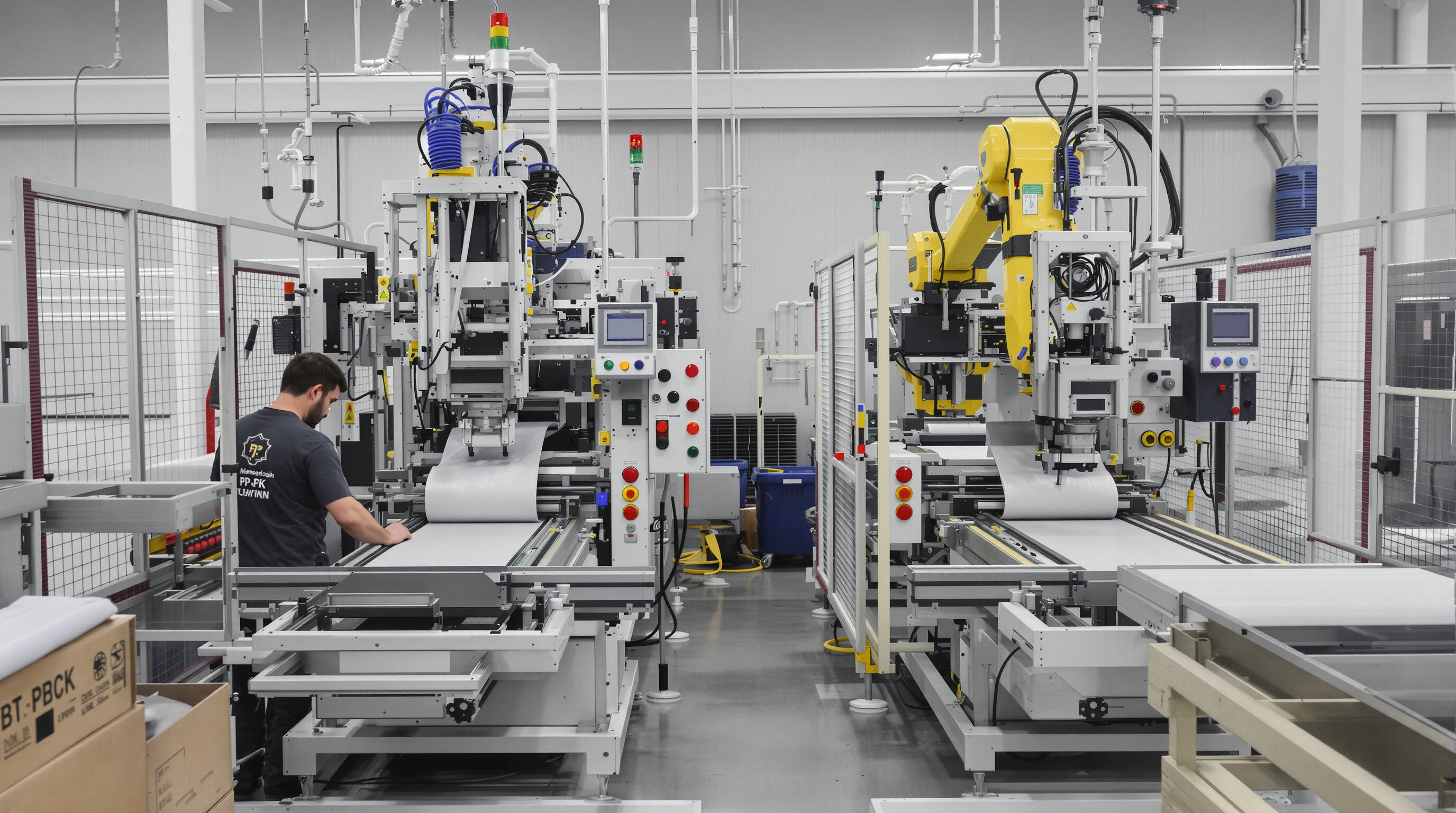Polypropylene (PP) bags have become an indispensable material in the modern packaging industry due to their durability, lightweight, and affordability. They are widely used in retail, agriculture, food packaging, textiles, and industrial sectors. To meet the growing demand for PP bags, manufacturers rely on advanced PP bag-making machines to automate production, improve efficiency, and ensure consistent quality. However, with so many models and configurations available on the market, choosing the right PP bag-making machine for your business can be challenging.
1.Understanding PP Bag Making Machine
PP bag-making machines are specialized equipment used to convert polypropylene rolls into finished bags through processes such as cutting, folding, sewing, sealing, printing, and punching. The design and functionality of the machine can vary significantly depending on the type of PP bag desired (woven, shopping, composite, or perforated).
Modern machines often incorporate automation, computer control systems, and servo motors to increase speed, accuracy, and reduce waste. Some even include options such as flexographic printing and lamination, allowing branding to be added directly on the production line.
2. Types of PP Bag Making Machines
Before choosing the right model, it's crucial to understand the main categories of PP bag making machines:
2.1 Woven PP Bag Making Machines
Designed for producing heavy-duty woven bags commonly used for rice, flour, cement, fertilizer, and animal feed.
Equipped with cutting and sewing units, they can handle sturdy fabrics.
Some models support bottom seams, top hems, and handle attachments.
2.2 Non-Woven PP Bag Making Machines
Suitable for eco-friendly bags such as shopping bags, promotional bags, and gift bags.
Ultrasonic welding is often used instead of sewing, ensuring stronger and cleaner seams.
A variety of bag styles can be produced: D-shaped bags, W-shaped bags, box bags, or bags with loop handles.
2.3 Laminated PP Bag Making Machines
These machines have an integrated laminating unit that laminates BOPP or other films onto PP fabric, enhancing printability and barrier properties.
They are ideal for high-quality retail packaging requiring branding and attractive designs.
2.4 Fully Automatic vs. Semi-Automatic Machines
Fully automatic machines: offer high output, low labor costs, and feature advanced features such as servo-driven cutting, touchscreen controls, and error detection.
Semi-automatic machines: offer lower investment costs and simpler operation, but require more manual intervention.
3.Understanding Automation Levels in PP Bag Making Machines

3.1 Comparing semi-automatic and fully automatic PP bag making machine models
Semi automatic models need someone around to handle feeding materials and check quality, but they do offer flexibility when dealing with custom orders without breaking the bank on equipment costs. Most of these machines can churn out between 60 to 100 bags every minute, so they work pretty well for new businesses getting started or companies running small production runs. Fully automatic polypropylene bag makers take things further by running almost entirely on their own once set up right. Basically, fabric goes in at one side and finished packages come out the other end with hardly any hands needed in between. These fully automated systems hit speeds over 200 bags per minute, which makes all the difference for big manufacturers needing steady output day after day. Industry reports suggest that factories switching to automation tend to see somewhere around 30 to 40 percent boost in efficiency when producing standard items consistently.
3.2 Key components that define automation level and operational efficiency
When it comes to automation capabilities, there are basically three main parts at work. First we have those precision feeding units equipped with tension control sensors. Then there's the programmable PLC systems that handle all the stitching and sealing parameters. And finally, there are the photoelectric inspection arrays doing their thing. The really advanced automation setups go one step further with built-in self correction features. These can spot problems as they happen, like when the WPP thread tension gets off track or prints start to misalign. For manufacturers running machines over extended periods, synchronized servo motors make a big difference. They cut down on wasted energy by keeping things running at just the right speed throughout production. Some studies show these systems consume around 15 to maybe even 20 percent fewer kilowatt hours than older gear driven models, which adds up nicely over time.
3.3 Balancing automation with flexibility for small to mid-scale production
Factory workers who deal with all sorts of different product runs really appreciate systems built with modular design principles. These setups let them upgrade piece by piece as business needs grow instead of replacing everything at once. Some machines combine automatic stitching control with manual switching options so they can handle those oddball order sizes that come along from time to time. The newer equipment comes with components that just slot right in place, making it possible to start with basic semi-automatic units and later add things like auto-stacking arms when production volumes pick up. This step-by-step method keeps money in the bank while still keeping most operations running smoothly even when expanding capacity, typically around 85 to 90 percent efficiency throughout the growth period.
4.Customization Capabilities of PP Bag Making Machines
PP bag making machines today come with all sorts of configuration possibilities that can tackle pretty much any packaging need out there. When it comes down to actually setting up these machines, manufacturers can adjust everything from bag dimensions to sealing techniques based on what the market wants. Most clients have very specific requirements, so getting those details right matters a lot. Cutting systems on these machines typically work across a wide range, handling materials between 200 and 1200 millimeters in width. For sealing, operators often choose between hot bar methods which are great for lighter retail products, or ultrasonic technology that works better for tougher industrial grade sacks needing extra durability.
Integrating handle types and perforation systems into production expands versatility. Machines equipped with servo-driven die-cutters seamlessly produce patch handles, loop handles, or reinforced die-cut grips. Simultaneously, micro-perforation modules create airflow-optimized produce bags or tear-notched disposal sacks, adapting to food-grade or waste-management applications.
Key configuration parameters include:
| Feature | Adjustment Range | Applications |
|---|---|---|
| Bag Length | 200–1,000 mm | Retail, agriculture, industry |
| Handle Type | Patch/Loop/Die-Cut | Shopping, logistics, waste |
| Perforation Pattern | Linear/Micro/Cross | Produce, hygiene, packaging |
By prioritizing modular design, manufacturers balance production efficiency with the ability to address niche markets—a critical advantage in the competitive polypropylene packaging sector.
FAQs on PP Bag Making Machines
1.What types of polypropylene are ideal for bag making?
Homopolymer PP is ideal for stiff, rigid bags, while copolymers perform well for foldable designs due to their cooler operating settings.
2.What automation level should I choose?
Semi-automatic models offer flexibility for custom orders and smaller production volumes, whereas fully automatic systems are best for consistent, high-volume production.
3.How do I determine the right machine specifications for my needs?
Match customer requirements with machine specifications like bag size, sealing type, and production capacity for optimal results.
4.How can material compatibility impact production efficiency?
Mismatches between fabric GSM ratings and machine setup can increase defect rates, impacting long-run efficiency.
5.What long-term considerations should be made when choosing a PP bag making machine?
Consider total cost of ownership, including operating expenses and after-sales support, as well as scalability for future upgrades.
Table of Contents
- 1.Understanding PP Bag Making Machine
- 2. Types of PP Bag Making Machines
- 3.Understanding Automation Levels in PP Bag Making Machines
- 4.Customization Capabilities of PP Bag Making Machines
-
FAQs on PP Bag Making Machines
- 1.What types of polypropylene are ideal for bag making?
- 2.What automation level should I choose?
- 3.How do I determine the right machine specifications for my needs?
- 4.How can material compatibility impact production efficiency?
- 5.What long-term considerations should be made when choosing a PP bag making machine?




